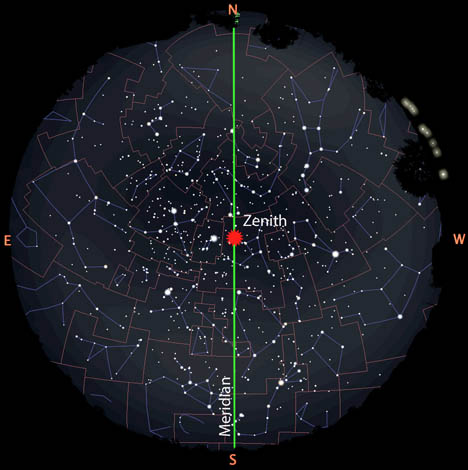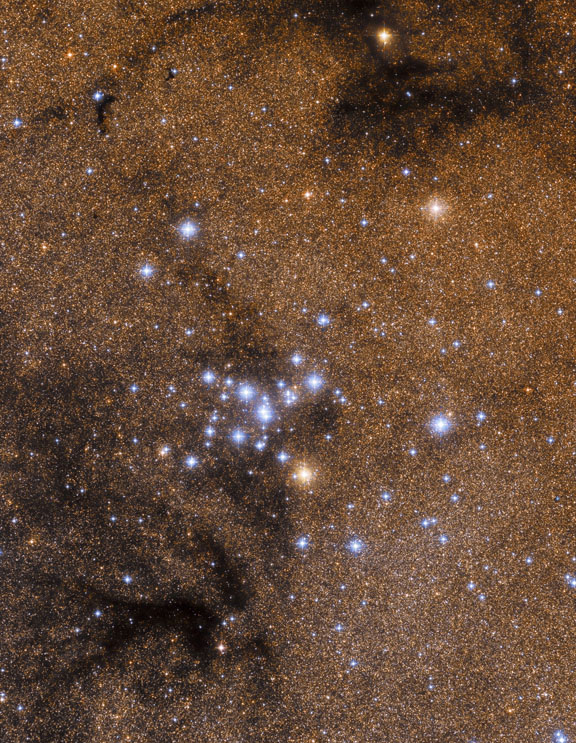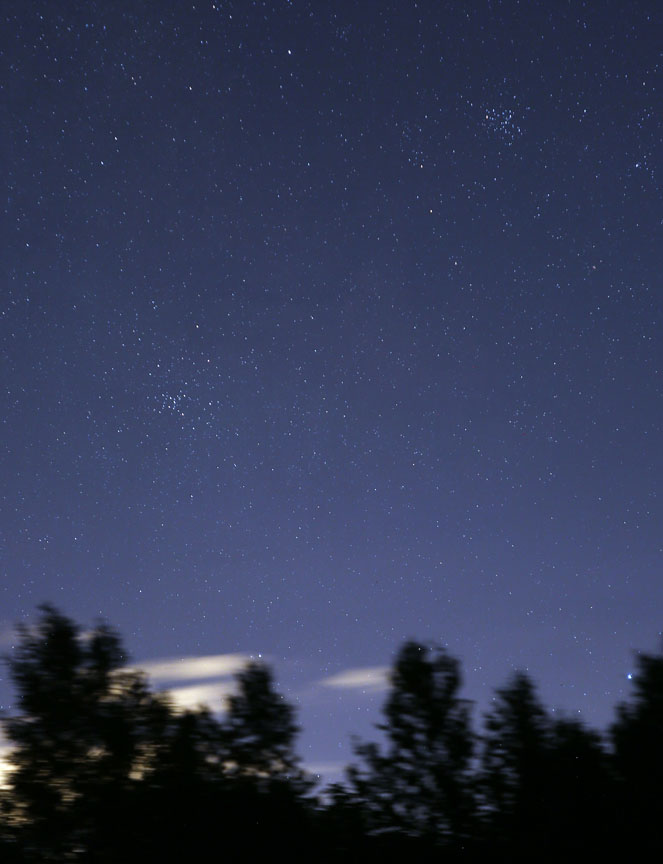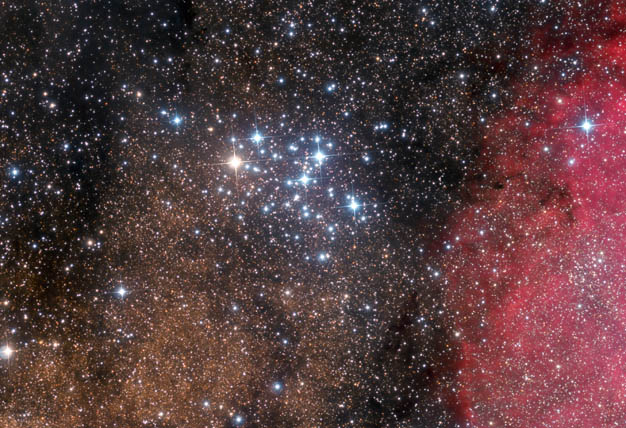Midnight Meridian Morsels
Late June offers a grab bag of clusters and nebulae "lined up" at the midnight hour. Time your southern deep-sky viewing with meridian passage and you'll be a happy camper.

Invisible to the eye, every experienced amateur skywatcher instinctively knows where the meridian is located.
Stellarium
Stellarium
The meridian's the place to be. No doubt about it. Stars and the deep-sky quarry we all love to explore begin their nightly arc in the east, reach their greatest height above the horizon when crossing the meridian, and then descend into the west.
The meridian begins at the due south point on the horizon, climbs to the zenith, then drops to the due north point on the northern horizon. A celestial object in the southern sky will be at its greatest altitude and seen most clearly through the least amount of atmosphere when crossing the southern meridian. Objects in the northern sky will be highest when they cross the meridian above the polestar and lowest (at nadir) when they cross it below the pole.
I'd be willing to bet most amateurs observe more objects on their way up rather than on their way down. There's a freshness to deep-sky objects when they first appear in the east and the pleasure of knowing that with every passing minute, Earth's rotation carries it higher and higher toward the meridian.

This map shows a slice of sky centered on the July 1st midnight meridian (RA = 17h 45m). We'll explore some two dozen clusters and nebulae within 1°–2° of the meridian. Click to enlarge, then save and print for use at the telescope.
Map: Bob King; Source: Stellarium
Map: Bob King; Source: Stellarium
Summertime brings great riches in the eastern sky for skywatchers. One of the richest parts of the Milky Waycourses through Scorpius, Ophiuchus, and Sagittarius, filling each of these constellations with visual and photographic treasures: dozens of globulars and planetary nebulae, scores of open clusters and bright nebulae, and too many dark nebulae to count!
How to make sense of it all? There are many ways to break down this bounty into manageable groups. For instance, you can select a bright star and star-hop your way from one deep-sky object to the next, the way you'd jump from rock to rock to ford a creek. Or you could choose to visit all of summer's globular clusters over the course of several nights.
Allow me to offer a slight variation — the "meridian package." Dobsonian owners will find this one of the easier ways to scoop up summer's southern clusters and nebulae. Point your Dob due south, and finding objects will involve a simple up or down push with a nudge east or west.
Of course, timing is everything. That's why I selected midnight local daylight time on July 1st. A ride along the midnight meridian on that date offers an incredible diversity of deep-sky objects within 1°–2° of vertical.
I can offer one for-sure guarantee — the objects, which inhabit the low southern sky, will be seen to their best advantage. So let's get started. The map above shows a strip of sky centered on the meridian with stars to magnitude 9.5 and a selection of deep-sky objects from about 10th magnitude and up. Since the rotating Earth makes everything in the sky a moving target, you might consider beginning a half hour before midnight to take better advantage seeing them all at maximum altitude.

This spectacular photo of the bright open cluster M7 also includes two prominent dark nebulae: Barnard 287 at lower left and Barnard 283 at top right. North is up.
Lorand Fenyes
Lorand Fenyes
Midnight may seem late but with twilight not over till after 10:30 p.m. from many locations, the hour arrives sooner than you'd think. Plus you have another option. Thanks to Earth's revolution around the Sun which causes the constellations to drift westward with the seasons, they'll be lined up north-south around 11:30 p.m. on July 8th, 11 p.m. on July 15th, and 10:30 p.m. on July 22nd.

The two large, naked-eye star clusters, M7 (left) and M6 (upper right) lie at the core of our meridian adventures.
Bob King
Bob King
All the objects lie near the Stinger Stars, Shaula and Lesath, in the tail of Scorpius, and concentrate around two bright, naked-eye star clusters, M6, a.k.a. the Butterfly Cluster, and M7, Ptolemy's Cluster. Most are open clusters, but two globulars, several oxymoronic faint, "bright" nebulae from the Sharpless H II list, and a healthy selection of dark nebulae from E. E. Barnard's famous catalog, spice things up.
The table below includes details and brief descriptions for 32 objects. I observed with a 10-inch f/4.5 Dob from northern Minnesota, where few climb higher than 10° during meridian passage. A few eluded my sight, but you may have better luck particularly if you live further south. I started at the Stingers and worked my way northward using the map to star-and-deep-sky-object-hop from one to the next, using magnifications of 57× and 115×.

The shape of the bright open cluster M6 in Scorpius is often compared to a butterfly. It lies in a rich region of the Milky Way. It's flanked by the dark nebulae B278 (left) and B275 (right).
Marco Lorenzi
Marco Lorenzi
Here are additional details on a few of my favorites:
* M6 and M7. For sheer brilliance and sparkle, these are incredible in both binoculars and small-sized telescopes. M6 looks like a plump moth, while M7 always reminds me of a sideways letter "K." The misty faint globular NGC 6453 makes for a nice challenge along its western border and an excellent comet imposter!
* What is it about Trumpler open clusters? Nearly every one I've seen has so much character and typically contains a nice mix of brighter stars that overlie a rich, misty backdrop of fainter members. The three on this list are no exception.
* Many Barnard dark nebulae can be low-contrast, difficult objects, but the two flanking M6 (its "ears") and Barnard 286, centered on a single bright star south of M7, stood out well enough at 57× even at their low altitudes.
* NGC 6383 looks like a bright star at first blush, but increase the magnification to around 100× and you'll uncover a dozen faint stars almost hidden in its glare. The stellar clutches of NGC 6451 and NGC 6400 were two more of my favorites. They're both small and lack the glamor of the big clusters, but they compensate with sugar-grain starriness.
Happy summer nights! May you so lose yourself in the spiral arms of the Milky Way that you completely forget the time.
| NAME | MAG. | SIZE | R. A. | DEC. | COMMENTS |
|---|---|---|---|---|---|
| Collinder 332 | 8.9 | 2′ | 17h 31m | –37º 04′ | Small, faint, nebulous in Lesath's glow |
| Ha 16 | ~8 | ~15′ | 17h 31m | –36º 50′ | Moderately rich cluster, E-W elongated |
| Collinder 333 | 9.8 | 8′ | 17h 31m | –34º 00′ | ~10 stars, loose, not concentrated |
| Barnard 271 | ---- | 120′ × 10-15′ | 17h 34m | –34º 15′ | Vague, low contrast dark nebula |
| NGC 6383 | 5.5 | 20′ | 17h 34m | –32º 35′ | Nice! 6 mag. star anchors a faint dozen |
| Trumpler 27 | 6.7 | 7′ | 17h 36m | –33º 29′ | Tiny bright stellar triangle on w. side. |
| Trumpler 28 | 7.7 | 6′ | 17h 37m | –32º 28′ | Very nice! Misty with faint stars. Rich. |
| NGC 6396 | 8.5 | 3′ | 17h 37m | –35º 02′ | ~10 stars with two close doubles |
| Collinder 338 | 8.0 | 20′ | 17h 38m | –37º 33′ | Couldn't confirm sighting |
| Barnard 273 | ---- | 15′ | 17h 38m | –33º 20′ | Another vague, low contrast nebula |
| Barnard 275 | ---- | 13′ × 4′ | 17h 38m | –32º 19′ | One of two dark "ears" either side M6 |
| NGC 6404 | 10.6 | 6′ | 17h 40m | –33º 14′ | Bright but sparse |
| NGC 6400 | 8.8 | 12′ | 17h 40m | –36º 57′ | Rich with faint stars, very pretty! |
| M6 | 4.2 | 33′ | 17h 40m | –32º 13′ | Spectacular! Butterfly cluster. |
| Barnard 278 | ---- | 15′ × 4′ | 17h 42m | –32º 18′ | Dark "ear" on east side of M6. |
| NGC 6416 | 5.7 | 15′ | 17h 44m | –32º 21′ | Cool anchor shape. Moderately rich. |
| Collinder 345 | 10.9 | 4.8′ | 17h 44m | –33º 52′ | Loose group of 15-20 stars |
| NGC 6421 star cloud | ---- | 45′ | 17h 35m | –33º 41′ | Nebulous appearance with faint stars |
| Collinder 347 | 8.8 | 10′ | 17h 46m | –29º 20′ | Small, loose cluster, arc-shaped |
| Sharpless 2-16 | ---- | 20′ | 17h 46m | –29º 23′ | Suspected "haze" with UHC filter. |
| NGC 6425 | 7.2 | 10′ | 17h 47m | –31º 32′ | Nice ~25-star brightish group. |
| Sharpless 2-19 | ---- | 12′ | 17h 49m | –29º 07′ | Not seen with or w/o UHC filter |
| Collinder 351 | 9.3 | 8′ | 17h 50m | –28º 46′ | Moderately rich, loose, not a standout |
| Sharpless 2-15 | ---- | 30′ | 17h 50m | –31º 16′ | Faint misty presence with UHC filter |
| NGC 6441 globular | 7.2 | 9.6′ | 17h 50m | –37º 03′ | Small, bright w/bright core. Granulated. |
| NGC 6451 | 8.2 | 8.0′ | 17h 50.5m | –30º 13′ | Lovely stellar thicket of ~50 stars |
| Barnard 283 | ---- | 75′ × 5′ | 17h 51m | –33º 52′ | Vague except for the darker w. half |
| NGC 6453 globular | 10.2 | 7.6′ | 17h 51m | –34º 36′ | Along w. edge of M7. Faint, comet-like |
| Barnard 286 | ---- | 15′ × ? | 17h 53m | –35º 37′ | Easy dark spot centered on bright star |
| M7 | 3.3 | 75′ | 17h 54m | –34º 47′ | Spectacular! Easy with naked eye. |
| Barnard 287 | ---- | 30′ × 5′ | 17h 54m | –35º 11′ | Small, dark "spot" with stars at core |
| Trumpler 30 | 8.8 | 20′ | 17h 56m | –35º 19′ | Beauty! ~20 stars in a stellar haze |
This is an advertisement. You may like to place order for footwears on Bata here:
https://linksredirect.com/?pub_id=11719CL10653&url=http%3A//www.bata.in

No comments:
Post a Comment